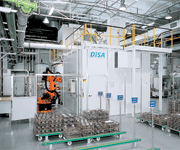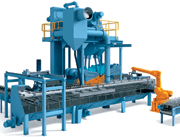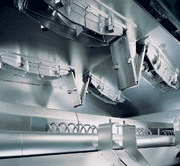E-Archive
Cover Page
in Vol. 7 - March Issue - Year 2006
DISA Makes An Impact On The Science And Technology Of Shot-Peening


Picture 1 and 2: 3-D model and operating picture of a satellite type shot peening machine with and without noise insulation chamber


Picture 3 and 4: 3-D model and operating picture of a rotary throughfeed shot blast machine

Picture 5: Robot loading / unloading of gear parts

Picture 6: Shot peening of springs with blast wheels

Picture 7: Crankshafts being shot peened on a DS machine
Shot peening is an established technology which is ideally designed to enhance the fatigue strength of components subject to high alternating stress. Shot peening using blast wheels offers a high level of flexibility and process reliability especially for larger series and larger workpieces such as gear parts, cams and camshafts, clutch springs, coil springs, connecting rods, crankshafts, gearwheels, leaf and suspension springs, rock drills, turbine blades, and many more.
The DISA Group, originally founded in 1900, is one of the world’s leading suppliers of foundry equipment and metal-surface finishing systems. Its strength in shot blasting came about through the merger of several front-runners in the business, including Georg Fischer, BMD, Vogel & Schemmann and Goff. For example, BMD, in 1855, patented its first centrifugal wheel sand blast machine in 1892. The organization’s earlier concentration on machines for the foundry industry led to the foundation of a line of equipment characterized by both high capacity and rugged construction.
Today, DISA is operating on a world-wide basis with competence centres and manufacturing sites in Schaffhausen (Switzerland); Hagen (Germany), Pribram (Czech Republic), Seminole (USA), Bangalore (India) and Changzhou (China). These undertake the development of new machines, carry out tests on behalf of their clients, involve themselves in concept engineering, and take on a number of other roles, including sales.
The range of DISA’s wheel blast equipment is impressive, covering almost every requirement of the manufacturing industry. It includes:
- Shot-blast systems for foundries, designed for sand removal, decoring, surface finishing and descaling. The machines include a variety of batch and continuous through-feed designs, such as reverse-belt units, oscillating-barrel models, hanger type arrangements and advanced manipulator machines for the cleaning of engine blocks and heads, both in iron and aluminum.
- Shot blast systems for the metal working industries. Single and in-line solutions for the descaling of steel strip, plates, sheets, wire and bar, forgings, shot blasting of rolled steel profiles, and cleaning of billets.
- Wheel blast solutions for shot peening of serial parts where the objective is to increase the fatigue strength of components subject to high alternating stress. The range embraces satellite rotation designs, rotary through-feed systems, advanced manipulator shot blast machines, enabling process-safe shot peening and overhead monorail versions or reverse-belt units.
Safe and reliable shot peening
While shot peening of parts in batches is still performed today, process reliability is becoming more and more important: Each part shall undergo a defined treatment. The blasting intensity must be controlled by determination of Almen intensity value and coverage. There are various machine designs available which comply with these requirements and which ensure that all parameters (throughput speed, blasting time, shot discharge speed, shot flow rate, shot size and distribution, and shot shape) are maintained per the specification requirement. Therefore it is possible to adjust and examine the Almen intensity and coverage. The process reliability is supervised in periodic intervals and can be guaranteed at all times. The DISA range of specialized shot peening machines has several important attributes:
- High-capacity blast wheels - the wheels are designed for high capacity and maximum energy efficiency. Available in several power ratings and in different configurations (including carbide alloy with curved blades), the ability to reverse their rotation considerably extends their application. Furthermore, the amount of shot employed can be adjusted from the operator’s panel.
- Dust removal and shot reconditioning; central to achieving success in the peening operation is a constant stream of well graded shot of a specific diameter range, hardness, and shape. Any crushed or broken shot needs to be removed throughout the cycle to avoid undesirable effects on the surface of the component. The returned shot is passed through a pneumatic separator whereby it is continually cleaned and reconditioned, thus keeping the media within its optimum size range. An electronic feeder adds new shot automatically to compensate for the removal of degraded material.
- Pre-programmed manipulation and exposure of surfaces to the blast stream - the majority of DISA machines designed for shot peening provide the means of processing individual parts through a sequence of movements, typically rotation or/and orienting, so as to ensure that the required areas are uniformly peened within a pre-determined time cycle.
Shot Peening Systems and their Application
Whereas small parts can be shot peened in batches (without defined process reliability), most machines are designed to meet individual part-specific requirements. They normally include peripheral equipment for loading and unloading and offer a certain flexibility for changing process or production requirements.
The SRS models (pictures 1 and 2) are particularly suited to the processing of gearwheels, bevel gears, crown wheels, gear shafts and other components in continuous cyclic operation. The machines can be adapted to the shot peening of flat or cupped parts, such as disc springs or clutch springs. Within the cabinet, beneath the stream of blast media, workpieces are rotated on satellite tables mounted on an indexing turntable. Such a machine can include as many satellites as needed for the specific application. The precise positioning of these miniature tables facilitates loading and unloading by means of robots or handling devices. The continuous rotation of each workpiece within the blast zone and the ability to adjust the rotational speed guarantees the attainment of defined Almen intensity values, and ensures optimum coverage. As a result, each and every part will be processed to the same level of perfection.
In the SRS Twist version, parts having progressed halfway around the turntable are robotically turned over to expose the reverse side to the blast stream. There are also opportunities to design the workpiece jigs in such a way as to accommodate two or three components at the same time, as for example a ring gear at the base, with a vertical shaft positioned above. The blast direction can be adjusted to suit the contours of the part/s, vertical, horizontal or a combination of both.
The successful peening of coiled springs poses the machine designer with the challenge of ensuring that all surfaces are equally covered by the impingement of shot. DISA’s answer has been the development of the RDS rotary through-feed shot peening systems (pictures 3 and 4). They are intended to shot-peen suspension and valve coil springs, with a diameter of 20-250 mm and in lengths from 30-600 mm, as they rotate horizontally under the blast stream. The systems offer impressive throughputs - up to 1,200 axial springs and up to 5,800 valve springs per hour. Coil springs are fed through the blasting zone on parallel horizontally-rotating rollers, being pushed forward through the blast by upwardly protruding fingers attached to an endless transport chain. Similar systems are available for the stress-peening of leaf springs.
Some components, such as crankshafts, because of their size, weight and complex configuration, need a different approach. DISA has designed the DS series, an extensive range of shot blast machines which can incorporate built-in manipulator arms serving to grip and turn workpieces as they are progressed through the abrasive stream. The arms are grouped in parallel sets of two or more, rotating in the same direction (picture 7). Crankshafts are then placed in the spaces between each arm, whereupon each component is caused to turn over and over. Such systems, depending on the model, can process up to 650 crankshafts per hour.
Automation and Peripheral Handling Equipment
Given the nature and quantity of components which are normally subjected to shot-peening, it is not surprising that the process lends itself to the use of industrial robots or customised pick-and-place handling devices to load the blast machines and retrieve the processed parts. An example of this is seen in the loading of an SRS satellite table, whereby a conventional multi-axis robot grasps a bevel drive pinion by its shaft, raises it vertically from a pallet and swings it into position above a fixture attached to one of the small satellite tables. An additional gripper device, mounted on the machine above the loading station, then descends to grasp the part by its toothed head, allowing the robot to release its hold and withdraw. The gripper then lowers the pinion into the fixture, releases it and returns to its original position. The sequence is repeated in reverse at the unloading station.
Shot Media and its Reconditioning
Reference has already been made regarding the importance of maintaining the exact size and uniformity of the shot used for peening. The media is likely to be either in the form of pre-rounded (conditioned) cut wire or spherical cast steel abrasive. During the course of the peening operation, there is certain to be degradation of the shot. The resultant malformed, fractured or undersized grains, if not speedily eliminated, will cause surface damage and provide initiation points for the propagation of cracks. One of the strengths of the DISA range of shot-peening systems is the Separation System which ensures that the size and shape of the media always remains at the optimum specification. As the degraded shot is eliminated, it is automatically replaced by the same amount of new material.
From a pure process control standpoint, conditioned cut wire shot is preferred for many shot peening applications. As cast steel shot degrades it breaks into sharp pieces, especially hard shot is used for peening carburized components. The sharp shot pieces can cause surface damage which weaken the surface by providing the crack initiation points referenced above. In contrast, conditioned cut wire shot maintains its spherical shape as it degrades. Rather than breaking into sharp pieces, it peels like an onion, thereby greatly reducing this surface damage risk and eliminating the need for shot shape control on the machinery. Cut wire shot also has about five times the life of cast steel shot. This longer life also makes process control of this critical parameter much easier.
Achieving Optimum Coverage
The impact coverage on the surface of the workpiece is a critical factor in determining the success of the peening operation. This parameter is a function of exposure time to the blast and shot flow rate. Coverage levels less than 100% will give rise to a number of problems, including early fatigue crack nucleation, whilst over peening will also accelerate fatigue crack initiation through over cold working of the workpiece surface resulting in strain cracking. The design of DISA machines facilitates the continuously regulated rotational speed of the workpieces passing through the blast stream, enabling the process to maintain the optimum shot impingement angle of 900, and assuring a predefined number of workpiece rotations within the blast cycle time. Combining precise workpiece positioning with closed loop electronic shot flow control provides for precise control of this critical process parameter called coverage.
The close control achievable over all the parameters involved ensures the achievement of the defined Almen intensity values coverage. The result is the impartation of a predefined residual compressive stress gradient uniformly across the entire peened surface of the part. When this is achieved, the process will deliver the maximum fatigue strength benefit available from the shot peen specification utilized. Developing the shot peen specification that will produce the optimum fatigue strength available for the particular metallurgical characteristics of the workpiece is beyond the intended scope of this paper, and may be described in a subsequent article.
For Information:
DISA Industrie AG
P.O. Box
8207 Schaffhausen, Switzerland
Tel. +41.52.631 1717, Fax 631 4888
E-mail: info.sh@disagroup.ch
www.disagroup.com



























